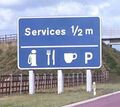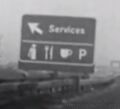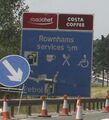Motorway Signs
< return to Road Signs This page gives a guide to all the different road signs associated with motorway service areas. Internal Signs have their own page.
While there's a lot of detail here, this page doesn't claim to be a technical or professional explanation. For that, you'd need to consult the TSRGD, the Traffic Signs Manual, and the latest regulations.
Mainline Signs
These are the main signs which are used on the motorway to tell drivers where the nearest service area is. These are basic signs that every driver should be familiar with.
Mileage Sign


The first sign is officially known as Diagram 2918 and it simply lists the distance to the next service area. Space permitting, it should be placed after every junction (after the route confirmatory sign), except at the last junction before a service area. The idea was to encourage people who can't wait that long to leave at the next exit.
For a while it used to be that these signs would include the service area after the next one, but this was seen as unnecessary - perhaps too many people were playing 'petrol station roulette'. The original wording given for these signs was "Next Services x miles".
This sign doesn't take into account any rest areas. All of the distances should be to the exit, not the service area itself, as if the service area is a few miles from the motorway drivers might see the signs and presume that they don't need to leave yet.
The signs are funded and maintained by the national highway authority.
For motorways without service areas, a Diagram 2918.1 can be used in its place. This says "No services on motorway", and it can be used on the motorway and on any approach to it. Diagram 2330 shows the more specific message "No services on M1", but that one is not allowed to be used on motorways. While that sounds strange, motorways may use the sign below to show which adjoining roads have service areas.
This leaves one more confusing scenario: where you have a gap between two motorways, this Diagram 2918 can still be used to refer to the service area on the next section of motorway, so long as the sign is only used while you are still on the motorway. This complication can apply to situations like the M42 heading towards the M1 and (in theory) on the M90. It could also apply to different gaps in the A1(M), but that would be bad practice, as there are other facilities provided on the A1 which can't be acknowledged from the motorway.
Remote Distance Sign

The 2016 documentation began to call this the 'Remote Distance Signage' (RDS), although authorities do like to rename things, so it's probably easier just to call it the 'List', or more formally, 'Diagram 2917'.
If there is a need for more information than the first sign provides, Diagram 2917 can be used. It's always displayed prior to each service area as well. It was based on signs used in Germany in the 1950s. Before a rest area, a sign in its place saying 'Rest Area 1m' should be used.
This sign differs because it lists the distance to several service areas, includes the operators (between 1982 and 2012 only), and can handle service areas on several roads which is important near motorway junctions or in areas with few service areas. This can quickly become complicated so it's important to follow the rules for consistency, or only show road numbers to reduce reading time. Only the next or next-but-one service area on each route can be included and only no more than three motorway routes should be included.
If there is a junction with another motorway before the next service area but that motorway doesn't have any service areas, then 'No services' should be used in place of the name and the distance. If the sign only covers the next two service areas on the road which you are currently on, then the road's number should be omitted.
While rest areas can't be included here, truckstops can, when followed by a symbol showing a HGV facing left. There had been some confusion as the 2013 guide was contradictory.
Service areas have been referred to by name since April 2012, and should be whenever this sign is fully replaced (but not if it's just patched). Between 1982 and 2012, service areas were supposed to be referred to by their operator, written in BLOCK CAPITALS. This was supposed to encourage competition, but it was stopped because the operators discovered they could change their name to include as much advertising as possible. Advertising isn't permitted in names.
These signs are funded and maintained by National Highways too. This sign, with the service areas' names omitted, could previously be used on A-roads approaching a motorway. There is one example on the A282, which wrongly provides operator names. The 2013 rules say this sign isn't permitted on A-roads at all.
Approach Sign

Perhaps the most important sign is the service station equivalent of an Advance Direction Sign (ADS). This is Diagram 2919.2.
It usually comes half a mile before a service area but this can be increased if the motorway is particularly busy or if the signs would interfere with more important signs. It has been known to appear up to five miles ahead of the service area.
The idea behind this sign was based on the original motorway junction signage, where the bare minimum information would be provided one mile before, with more detail given at half a mile.
The signs are property of the operator, and are funded by them. They can include a 'now fully open' sign - see the next section.
This sign has changed a lot over time, older examples are explored below. As of April 2012 it is usually just an assortment of brand names - up to six are permitted, plus the operator's.
The operator header board is now displayed in the middle of the sign. The six symbols should come in the order fuel, refreshments, other, with accommodation last. Generic fuel, electric car, restaurant, coffee, and accommodation symbols from the old-style sign can be used instead, and all six spaces don't need to be filled. The same brand shouldn't be used twice. There are some guidelines on keeping brand logos clear, but logo design is mostly unregulated and left to each brand's corporate style guide. The signs should be kept updated, but this can be challenging on motorways without a hard shoulder.
This sign design was trialled in 2011. It was introduced to address the problem where operators were creating subsidiaries with names like "Costa BK M&S" to allow them to promote themselves while simultaneously protesting against the regulations that forbid advertising. Operators were very keen on the revised sign, which they had been lobbying for since 2005. They rolled it out almost nationwide immediately. By the 2020s, only a handful of sites still had the old signs, which were mostly owned by Moto.
Rest areas still have a similar sign, but without any branding. The branding trial only covered this sign and the truckstop sign. A service area name is normally given on this style of sign, but it isn't mandatory.
Further Changes
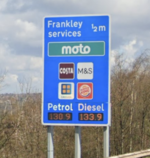
In January 2020, two modified installations of this sign were permitted. These would be placed either side of Frankley services, and would now display four symbols plus the current price of petrol and diesel, omitting the fuel brand.
The revision is called "NP 5016" and it effectively reintroduces a feature of the 1982-2012 sign which had been totally left out of the new one, although it now displays two fuel prices instead of one. Moto announced in February 2021 that the new sign had been a success, and that "national network authorisation" had been provided by National Highways - though it's not entirely clear what this involves as authorisation isn't what National Highways are supposed to deal with.
Whatever the legalities, Moto said their new bespoke sign would be introduced to three more locations, and they suggested it could be rolled out nationwide, even outside National Highways's territory of England. It's not clear whether other operators will want to use this sign too, or whether this new dose of enthusiasm for advertising fuel prices will last and the electronic equipment will be maintained. That's important because, while electronics are more reliable than they were in the 1980s, many motorways don't have hard shoulders any more which means maintaining road signs is difficult.
Northern Ireland
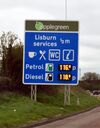
In Northern Ireland, a combination of both the old and the new Diagram 2919.1 are used. The first sign is of the new design, with the six brand logos. The second is the old design, with a few symbols and an electronic board to display the price of both unleaded and diesel fuel. This is demonstrated on the right.
Diverge Sign
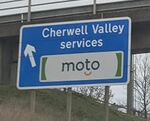

At the start of the exit for the service area comes 2920.1, also known as the 'slip road sign' or (in the 2025 update) the 'final direction sign'. This sign simply states the name of the service area, with an arrow and the operator's header board.
Since April 2012, the operator's logo has again been moved to the centre of the sign, with no other brands included. Between 1982 and 2012 it was positioned on the top. Both examples are shown here.
The 2025 update stresses that this sign is now optional, and is redundant if "Services" can be used on existing direction signs, especially if there are already a lot of signs.
Some Moto service areas used to say "Services Frankley", rather than the more logical way around. That's some-sort of oddity which arose when a particular batch of Granada signs were manufactured - it wasn't permitted. These were mostly fixed in 2012. Until 1981, signs like these had "Services" in mixed case; from 1994 it was lower case only, but it took a while for this to catch on.
These signs are also property of the operator. They are there primarily to reassure drivers that the next exit is a service area.
In Northern Ireland, the old style of sign (like the second one pictured) is used for all installations.
Now Fully Open
In the second example photo is a sign saying 'now fully open'. These used to be written in black-on-yellow and displayed next to signs for service areas which had been under significant refurbishment or a phased opening. They are supposed to be removed after six months, but almost never are.
It's not clear if there is still a blanket authorisation for them, but they are certainly still used.
Supporting Signage
These signs help the motorist get from the motorway to the service area itself. Again, they should all be self-explanatory.
Exit Sign


Since 2002 Diagram 2921.1 has an arrow pointing to the top-left, like similar signs usually found at a junction (those are Diagram 2910). The 2025 update calls this the "confirmatory direction sign".
Until then, a Diagram 2921 was used at the exit into a service area, which has a left-pointing chevron. The problem was the chevron implied the exit was at a right angle, which wasn't usually the case, and was a restriction which only applied on motorways. The top photo shows the chevron (and the problem with it, since the slip road clearly runs in a straight line) and the bottom one shows the newer alternative. The chevron can still be used where appropriate.
If the service area is at a junction, then the legend 'Services' may be added to any existing exit sign, and to any other direction signs, unless this would lead to an overload of information. It is actively encouraged to attach this to gantry signs and similar, where possible, but that is rarely done. One issue is that England's national highway authority almost always replace motorway signs like-for-like, rather than standing back and looking for opportunities to consolidate information.
These signs are the highway authority's property and shouldn't include any advertising or facilities information. Exit signs must not even give the service area's name.
Continuity Signing
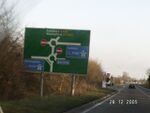
Where the service area isn't immediately accessible from the road, the legend 'Services' on a blue patch should be used to direct traffic to the right place. The clarity and quality of this signage can be especially variable; it is almost always provided in the wrong colour.
Using the full name is also acceptable, but rare. When painted on the road, it should be written as "SERV", not "S'VCS" (even though, on electronic signs, "SVCS" is used).
Where two competing service areas are positioned at the same junction, the regulations don't offer any advice as to how the two different destinations could be differentiated. This was never a problem for motorways (unlike A-roads) because two competing motorway service areas couldn't be built next to each other, but that rule was removed in 2013 and it could become a problem at Bridgwater.
Very pedantic note: Although there is no ban on using this style of signage to refer to "a generic description of a facility", it's extremely unlikely to ever be necessary. If you are on a motorway approaching a roundabout where one of the exits leads to a restaurant that doesn't qualify as a full motorway service area but you still want to tell people what's down there, you would be allowed to use the word "Services", but it would have to be written in black-on-white because it's pointing at a local facility on a local road. The only time it could ever be written in blue would be if you had to travel down another motorway to get there, in which case your little restaurant probably doesn't deserve all those direction signs anyway.
End of Motorway Regulations
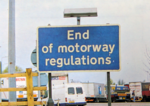
There was 15 years of debate over what an end of motorway sign should look like, during which a simple sign saying "end of motorway" was used. Although this was initially used at service areas, a separate "end of motorway regulations" was created to avoid confusion. Its purpose is to mark the end of the 'no stopping' order which had been given at the start of the motorway.
Start and end of motorway signs now use symbols rather than text, but even so the "end of motorway regulations" sign survives and is supposed to still be used at the entrance to online service areas. The 2025 guide specifically says that the end of motorway symbol "must not be used" in place of this one - yet the wrong sign continues to be widely used.
Other Signs
These signs are generally redundant or rarely used. They have been included for your interest, and for the benefit of anybody who needs to know their background.
Tiredness Can Kill
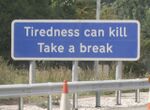
This is an optional sign reading 'Tiredness Can Kill, Take a Break'. In the 1990s the Highways Agency placed them along roads where there was likely to be a high number of fatigue-related accidents. The phrase has become a regular road safety campaign.
These signs are usually placed two miles before a service area to remind drivers to take a break without encouraging them to stop somewhere unsuitable. There are some exceptions: the M5 has them in several places simply because the road is dull.
Contrary to popular belief, these are put up by and maintained by the national highway authority, who normally choose the locations for them too. In the early 2000s some operators did pay to have these signs installed next to their service areas. No study has been done into whether they get more people to stop or reduce accidents.
Although no new installations of this sign have been put up, some have been replaced. It doesn't appear to be in the Traffic Signs and General Directions (TSRGD) and there have been a few variations on how it's used.
A similar campaigning phrase that is often associated with service areas is "check your fuel level". Again, while this is generally placed next to a service area so that the message will be more effective, no actual research has been done into whether the service area benefits from this, and service areas aren't able to request that they get these signs.
"Check your fuel level" is normally used during temporary government campaigns, or at places where vehicles running out of fuel have been particularly disruptive. Examples of those include roadworks and the approach to tunnels.
Services Open As Usual
In local roadworks, it is common to use "businesses open as usual" to try to prevent passing trade from being deterred from stopping. On the motorway, this is often varied to "services open as usual", even if it's not particularly causing confusion.
Fuel Prices
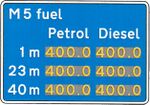
In October 2013, the Department for Transport announced as part their policies aiming to make life easier for motorists a new sign which would compare the prices at upcoming service stations. The introduced sign (right) was slightly different to the original.
The trial, running from August 2015 to 2017 on the M5 southbound between J17 and J30, allowed signs comparing petrol and diesel prices at up to three service areas.
After the signs were removed, the trial was quickly forgotten. Many users of the M5 had commented that the new signs simply advised that all service stations were selling fuel for the same price. In January 2020, a similar layout was used on two new experimental signs at Frankley, which would provide fuel prices at Frankley only.
Older Signs
The Diagram 2919.1 discussed above has changed many times.
The first example shows the original prototype of Diagram 2919.1; a grey-on-yellow version was also considered to have it stand out, as was a diagram having the exit loop back round. Motorway Services Ltd wanted to see the signs hung from bridges. On another early drawing, the cup was given a saucer, the fork was used without the knife, a tear drop was used to show petrol stations, and amazingly it was considered using a wine glass to symbolise a restaurant. Symbols were used to show both the 'cafeteria' and the 'restaurant', a distinction which still applies today, even if it seems less relevant.
It was decided not to use the map. Those symbols were going to be in their own rectangles, but those rectangles were taken out to keep it tidy. The parking square was going to have a red background to have it stand out. The service area name was later added to the sign; the sign at Strensham hung on until 1993. The Diverge Sign had an arrow, the Approach Sign was exactly the same but without an arrow.
Anderson signs like the second example were phased out in the 1960s, and Worboys signs were introduced. These had only minor changes for service areas, to keep the signs in line with the rest of the new motorway signs. As before, an arrow was added for the Diverge Sign only. During the conversion, many existing signs were amateurishly bodged, with a name or new symbols added.
One curiosity with the Worboys signs was that the 'knife and fork' symbol was changed to a 'spoon and fork', which today looks very odd. This was the designer's choice; some historians suggest that buying a meal that needed a knife was unimaginably luxurious for most people in post-war Britain.
Second Revision
The Prior Report of 1978 suggested that motorway service areas should have to share their fuel prices. Operators said they would only do this if they could promote their name. This led to one of the fifth example. Previous signs were supposed to have been removed by 2005, but as of 2021 two examples from this set are still in place at Stirling.
The operator's logo should be adjusted to match the width of the sign and to be no more than three times the height of the capital letters on the sign. The petrol price used to be updated manually until the 2000s, when it started to be covered up or omitted. The 1981 TSRGD showed the fuel price as 45p, and the price gets updated in most revisions.
The disabled symbol was dropped in 2010 and was supposed to be replaced by a picnic area symbol. Extra symbols could be added to show a restaurant, hotel and LPG. The fuel symbol was reviewed in 1994.
When these signs started to be removed in 2012, many of them were original installations (dating back to 1982 or since). Some of them had been patched many times, with new symbols, new operator names, new fuel prices and even new service area names, but they were usually same 1980s sign underneath. These signs are now required to be removed by 30 January 2022, although as with most old road signs there are likely to be some that get forgotten.
The Diverge Sign was also revised in 1982, with the symbols being removed and operator header board being added. Some signs had the wording the wrong way round, reading "Services Hilton Park", but this was an error. Some service areas at roundabouts had these, or attempts to recreate them, placed on the roundabout. These signs were also replaced in April 2012, with a new version that has the operator logo in the middle of the sign. This is except in Northern Ireland, where the 1982 version is still being installed in places.
-
The temporary fuel sign that was used on the M1 before the restaurants opened.
-
The prototype services sign. Rendered from a rough sketch.
-
The original Approach Sign. It was part of a set of signs known as Anderson.
-
The original Diverge Sign, another from the Anderson set.
-
A later example of a Diverge Sign, part of the Worboys motorway signs, many of which remained until 2012. Note the spoon.
-
Another Worboys sign; this is the Approach Sign. The photo was taken in 1983 so it was probably about to be replaced with the updated sign.
-
Significant changes were made to the Approach Sign in 1982.
-
The Diverge Sign with the headerboard added, pictured in 1986. This logo was made slightly too small by error.
-
A patched Approach Sign, pictured in 2007, with slightly changed symbols and an example of the advertising creep.
To save money, some 1982-style signs were created by simply attaching a logo to the top of an existing 1970s sign. The giveaway for this was the symbols being wrongly used below. Some of these lasted until the 1970s. One of these appears to still be in place at Lancaster.
The Keele Sign
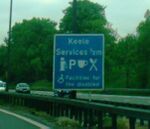
A single sign for Keele services attracted considerable intrigue. It was placed in the central reservation, half a mile before the southbound service area, a position which must have been an experiment which was only repeated at Strensham. The sign's design suggests it was installed in the 1970s: it had the old petrol pump symbol, a parking symbol, a coffee cup, a spoon-and-fork and the outdated boast, "facilities for the disabled".
As the sign was surplus to requirements it couldn't be replaced, only removed. But it was in a difficult position to reach and it wasn't misleading or a safety hazard, so it wasn't worth removing, and instead it hung on, prompting questions from the occasional curious motorist. By the early 2010s, this was one of the oldest signs on the motorway network and was virtually illegible to passing traffic.
The sign eventually fell off its posts in April 2024, and was then classed as a safety risk which needed to be removed. A staff member brought this to the attention of Aldridge Transport Museum, who saved it from being scrapped, and are now taking care of it. It's believed to be the first time a blue motorway sign has been preserved like this, and one of the oldest motorway signs not to be scrapped.


